| WARNING â– If you have a flat tire Do not continue driving with a flat tire. Driving even a short distance with a flat tire can damage the tire and the wheel beyond repair, which could result in an accident. |
Before jacking up the vehicle
Location of the spare tire, jack and tools
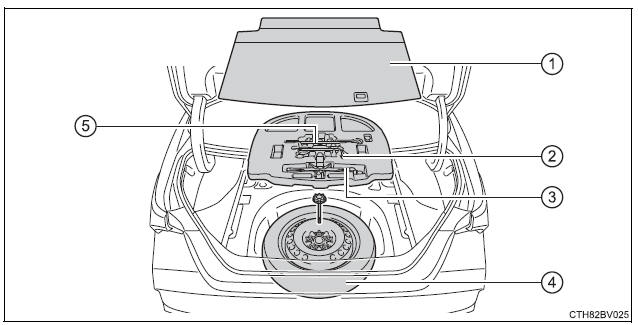
| WARNING â– Using the tire jack Observe the following precautions. Improper use of the tire jack may cause the vehicle to suddenly fall off the jack, leading to death or serious injury.
|
| NOTICE â– To prevent damage to the vehicle when using a jack When jacking up the rear of the vehicle, make sure not to position the jack under the bracket shown in the illustration near the rear jack point, as the vehicle body may be damaged.
|
Taking out the jack
1. Lift up the hook of the luggage floor cover on the trunk floor.

2. Secure the luggage floor cover using the hook provided.
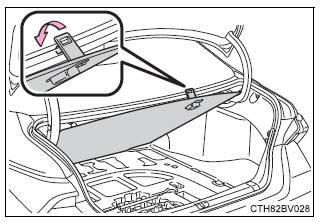
3. Remove the jack.
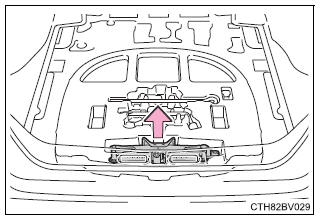
Taking out the spare tire
1. Lift up the hook of the luggage floor cover on the trunk floor.
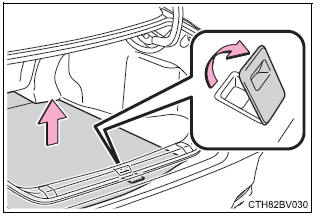
2. Secure the luggage floor cover using the hook provided.
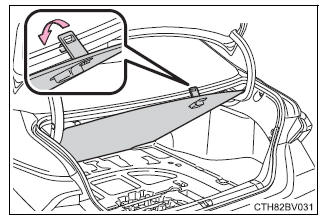
3. Remove the tool tray.
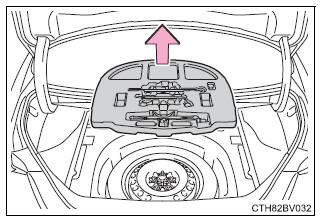
4. Loosen the center fastener that secures the spare tire.
When taking out or stowing the spare tire, make sure to firmly hold opposite end of the tire.

| WARNING â– When storing the spare tire Be careful not to catch fingers or other body parts between the spare tire and the body of the vehicle. |
Replacing a flat tire
1. Chock the tires.
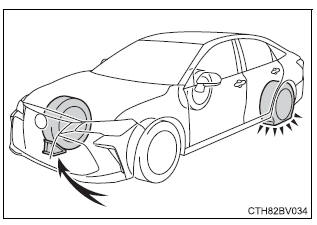
| Flat tire | Wheel chock positions | |
| Front | Left-hand side | Behind the rear right-hand side tire |
| Right-hand side | Behind the rear left-hand side tire | |
| Rear | Left-hand side | In front of the front right-hand side tire |
| Right-hand side | In front of the front left-hand side tire | |
2. Slightly loosen the wheel nuts (one turn).
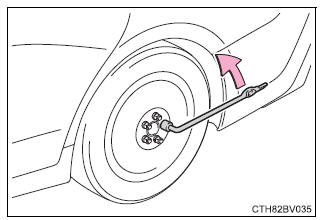
3. Turn the tire jack portion "A" by hand until the notch of the jack is in contact with the jack point.
To prevent damage to the vehicle when using the jack, position the jack in the correct location.
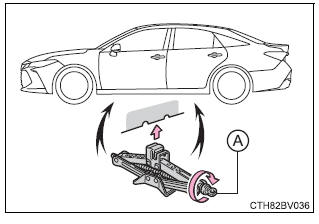
The jack point guides are located under the rocker panel. They indicate the jack point positions.
4. Assemble the jack handle.
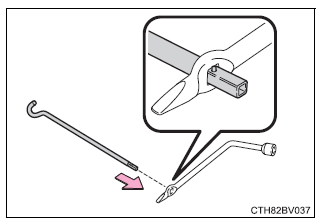
5. Raise the vehicle until the tire is slightly raised off the ground.
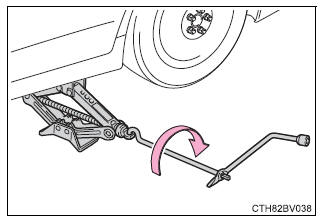
6. Remove all the wheel nuts and the tire.
When resting the tire on the ground, place the tire so that the wheel design faces up to avoid scratching the wheel surface.
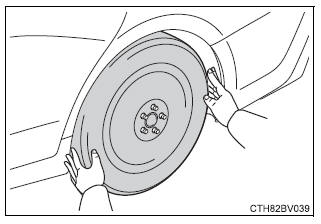
| WARNING â– Replacing a flat tire
|
Installing the spare tire
1. Remove any dirt or foreign matter from the wheel contact surface.
If foreign matter is on the wheel contact surface, the wheel nuts may loosen while the vehicle is in motion, causing the tire to come off.
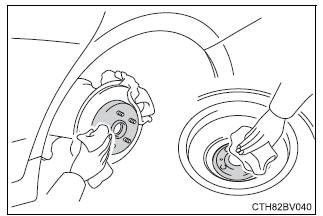
2. Install the tire and loosely tighten each wheel nut by hand by approximately the same amount.
Tighten the wheel nuts until the tapered portion comes into loose contact with the disc wheel seat.
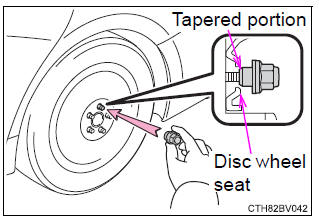
3. Lower the vehicle.
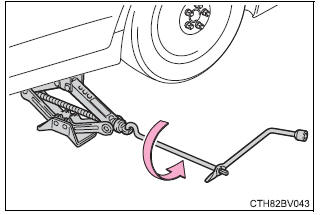
4. Firmly tighten each wheel nut two or three times in the order shown in the illustration.
Tightening torque: 76 ft*lbf (103 N*m, 10.5 kgf*m)
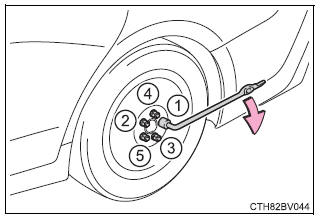
5. Stow the flat tire, tire jack and all tools.
â– The compact spare tire
Use the compact spare tire temporarily, and only in an emergency.
â– When using the compact spare tire As the compact spare tire is not equipped with a tire pressure warning valve and transmitter, low inflation pressure of the spare tire will not be indicated by the tire pressure warning system. Also, if you replace the compact spare tire after the tire pressure warning light comes on, the light remains on.
â– When the compact spare tire is equipped When driving with the compact spare tire installed, the vehicle height will be different than when driving with standard tires.
â– If you have a flat front tire on a road covered with snow or ice Install the compact spare tire on one of the rear wheels of the vehicle.
Perform the following steps and fit tire chains to the front tires:
1. Replace a rear tire with the compact spare tire.
2. Replace the flat front tire with the tire removed from the rear of the vehicle.
3. Fit tire chains to the front tires.
| WARNING â– When using the compact spare tire
â– When the compact spare tire is attached The vehicle speed may not be correctly detected, and the following systems may not operate correctly:
*: If equipped â– Speed limit when using the compact spare tire Do not drive at speeds in excess of 50 mph (80 km/h) when a compact spare tire is installed on the vehicle. The compact spare tire is not designed for driving at high speeds. Failure to observe this precaution may lead to an accident causing death or serious injury. â– After using the tools and jack Before driving, make sure all the tools and jack are securely in place in their storage location to reduce the possibility of personal injury during a collision or sudden braking. |
| NOTICE â– Be careful when driving over bumps with the compact spare tire installed on the vehicle. The vehicle becomes lower when driving with the compact spare tire compared to when driving with standard tires. Be careful when driving over uneven road surfaces. â– Driving with tire chains and the compact spare tire Do not fit tire chains to the compact spare tire. Tire chains may damage the vehicle body and adversely affect driving performance. â– When replacing the tires When removing or fitting the wheels, tires or the tire pressure warning valve and transmitter, contact your Toyota dealer as the tire pressure warning valve and transmitter may be damaged if not handled correctly. â– To avoid damage to the tire pressure warning valve and transmitters When a tire is repaired with liquid sealants, the tire pressure warning valve and transmitter may not operate properly. If a liquid sealant is used, contact your Toyota dealer or other qualified service shop as soon as possible. Make sure to replace the tire pressure warning valve and transmitter when replacing the tire. |
Toyota Avalon (XX50) 2019-2022 Service & Repair Manual > Electronically Controlled Brake System(for Hv Model): Air Bag Circuit (C147D). Master Reservoir Level Malfunction (C1202). ECM Communication Circuit (C1203)
Air Bag Circuit (C147D) DESCRIPTION The skid control ECU (brake booster with master cylinder assembly) receives the secondary collision brake control request signal from the airbag ECU assembly. DTC No. Detection Item INF Code DTC Detection Condition Trouble Area MIL Note C147D Air Bag Circuit 451 A ...